How to swim in the pool?

Everyone finds their own reasons for visiting the pool. It is important for some to lose weight without applying serious efforts and exhausting training for this, others want to keep their body in good shape, while others are primarily concerned about health. Swimming is often chosen by parents who are interested in the development of their children. We will talk about how to make classes pleasant and safe in our article.
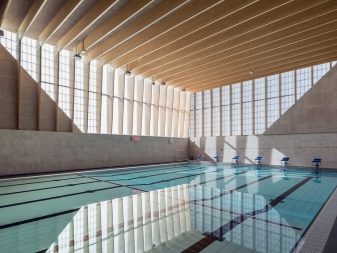
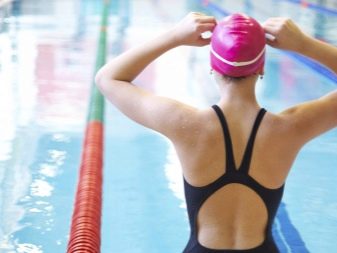
Safety regulations
It must be said that the pool is considered to be a place of increased risk. For the classes to be safe, swimmers need to follow a number of rules and recommendations that will help protect them from possible injuries and accidents. The main person in the pool is the coach or instructor. All classes are usually conducted under his careful supervision. Accordingly, the instructor's requirements are mandatory. Let's get acquainted with the basic safety rules that should be known to every person.
- The start and end of the workout is indicated by the instructor.... He does this with the help of a prearranged signal. Entering and leaving the water is permissible only with his permission.
- Swimmers move counterclockwise in the water. This rule always applies. This is especially important when there are several swimmers on the same lane. You need to keep to the right at all times, this will allow you not to bump into other visitors on the walkway and not interfere with them. Overtaking is, on the other hand, on the left.
- There are situations when during training the student gets tired and needs rest. In this case, you need to move to the corner of the track. This will help not to interfere with swimming for neighbors.
- If water gets into your mouth or nose and you need to get rid of it, you should pay attention onto the drain gutter.
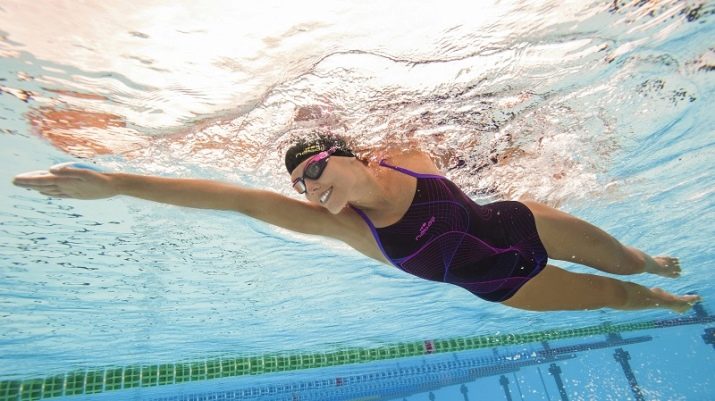
There are a number of restrictions that visitors to the pool must also adhere to. For example, It is strictly forbidden to swim without a special cap. You cannot jump from the sides of the pool, it can injure other visitors or yourself. Also it is forbidden to push, "hang" on the path, make noise and chew gum.
In addition, it is forbidden to swim across the pool, as this may interfere with the rest of the practitioner. Under no circumstances should you give false signals for help., in some cases it can lead to panic, and on the water it is very dangerous. Do not interfere with other athletes, you must show respect for each other.
Compliance with these rules will ensure safety not only for yourself, but also for those around you.
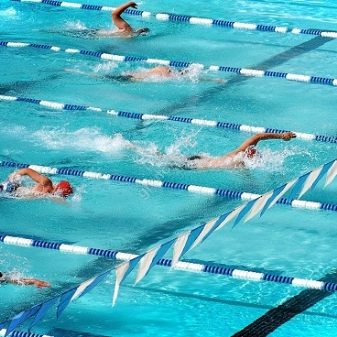
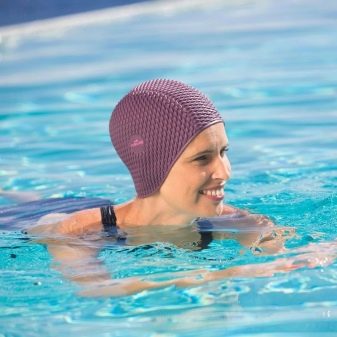
Technique
The basic principle of swimming is the need to stay on the water, lowering your head into it, and at the same time keeping your body stretched. There are only four generally accepted methods of swimming, and they all have their own characteristics. Let's consider each of them.
Crawl
In the process of swimming, hand strokes are performed alternately like a mill... The legs move alternately, which outwardly resembles the work of scissors. The head turns in one direction or the other. This is necessary in order to inhale.
This swimming style is considered the most comfortable. Movement in the water is fast enough. Swimmers say it is very easy to master.
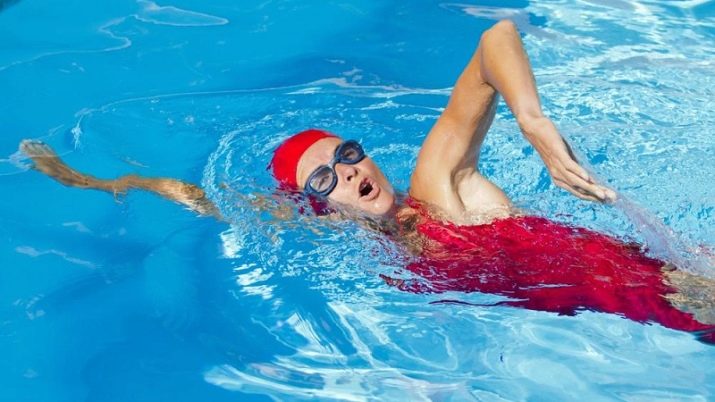
Breaststroke
This style looks very impressive. With both hands, a stroke is made towards you. At this time, the head rises significantly above the water in order to inhale. The moment the arms are thrown forward, the head is submerged under the water. Kicking mimics the movements of a frog.
Swimmers note that breathing is more comfortable here than in a crawl. However, the style itself is not at all simple. It is believed that the most difficult thing is to work with the legs and arms synchronously. If this is not the case, the movements of the legs will slow down the body of the athlete, rather than accelerate it.

Butterfly
This style is also called "dolphin". It gives the maximum load to the muscles. For this reason, only experienced and trained swimmers decide to use it. You should still start with the crawl and breaststroke.
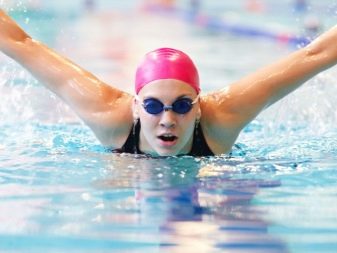
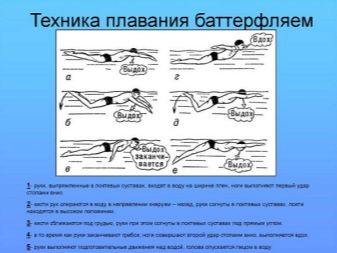
On the back
This swimming technique usually involves a crawl, with the difference that the athlete is on his back, not on his chest. Hands move in the manner of a "mill", and legs swing. Swimmers find it easiest to stay on their backs. However, there is a drawback, and it is quite significant. In the process of swimming, the face is directed upwards, so the person does not see where he is moving.
With this technique, you can take a short break or diversify your workout. The method is used as an additional one.

How to breathe correctly?
The main reason people make mistakes when swimming is to breathe. However, experts say that everything is not as difficult as it seems. You can learn to breathe with your head in the water by spending just a couple of days on classes. You need to remember the basic rule - exhalation is performed at the moment when the face is lowered. It can be done both through the nose and through the mouth. Even small children master this technique. Training can take place under the guidance of an instructor or independently.
In order to learn how to breathe out into the water, you should proceed as follows. First you need to stand at the side and put your hands on it. Without letting go, the face is immersed in water, and the air is exhaled.
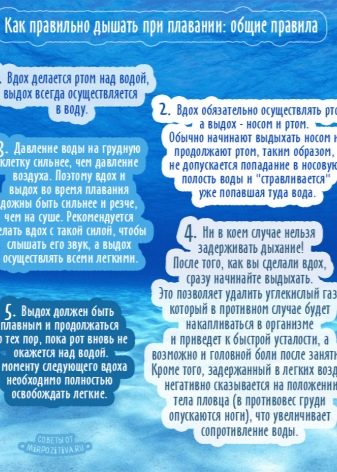
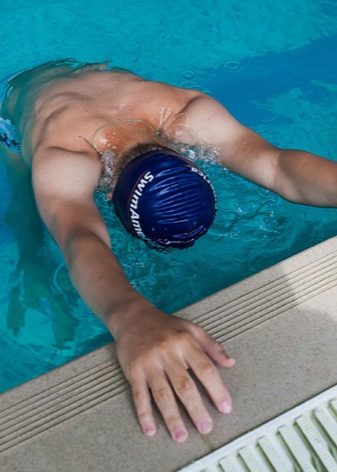
Next, you need to take a swimming board and, holding on to it, swim a little, with your face down. Since the body in such a situation does not need to be held, one should move with the help of the legs. For inhalation, the head rises above the water; for exhalation, it descends again. After short training, the swimmer usually understands how to do it more conveniently, and the process ceases to be difficult.
When it comes to crawl or breaststroke swimming, the breath is taken, respectively, either when the head is turned to the side, or when it is raised.... Such activities help to understand that swimming with a neck that is constantly tense is much less pleasant than breathing in water. In addition, stress on the vertebrae is unlikely to be beneficial.
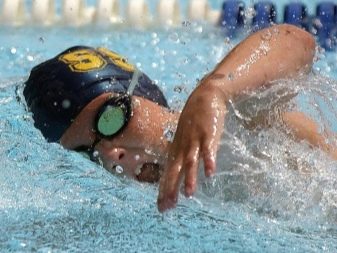
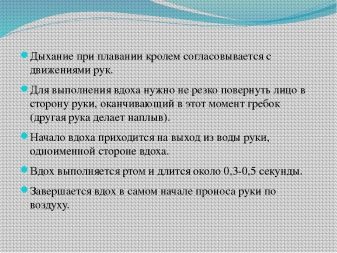
How to build muscle by swimming?
Swimming is practiced not only by those who want to tighten their bodies and improve their health, but also those who plan to build muscles. The main ones involved during classes are muscles of the back and shoulder girdle. The deep muscles of the spine are also under tension. All of them help to form a correct and beautiful posture. The necessary load will prevent the curvature of the spine. It also holds the spinal discs in place, which makes swimming very popular in physical therapy to restore the back.
A significant load during training will fall on the press and core. Biceps and triceps are involved. However, it cannot be said that swimming only develops a specific muscle group. This point will be influenced by which technique is used.
The duration of training and the correctness of the movements are also important.

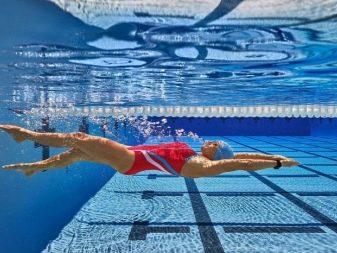
Before swimming, some people think that in this way they will be able to build muscle without additional effort. However, experts note that workouts help exclusively keep the body in good shape and are not a magic tool without a set of special classes... Of course, muscles and ligaments will be significantly strengthened, coordination of movements will become more developed. But building mass through regular activities in the pool is simply unrealistic if you do not do it around the clock and without interruptions.
At the same time, swimming can be called one of the best ways to improve performance and increase muscle strength. It helps to strengthen the ligaments and tendons, making them more elastic. The muscles themselves will become longer and more resilient over time.
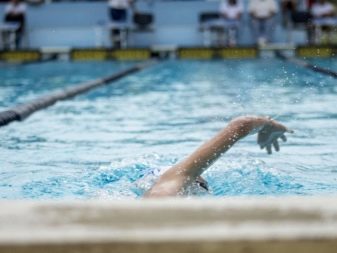
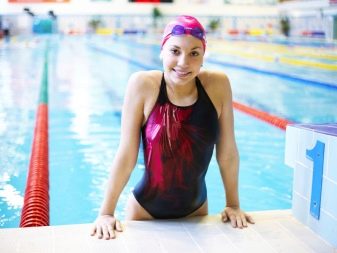
What is important to know and where to start when you first workout in the pool, see the next video.








